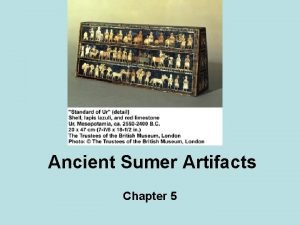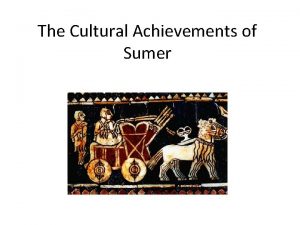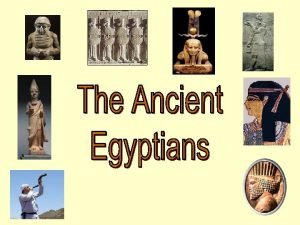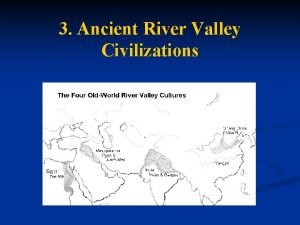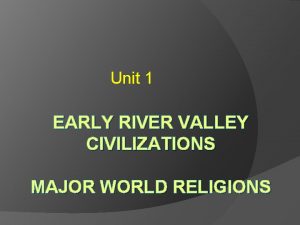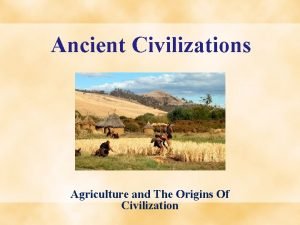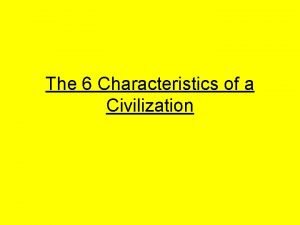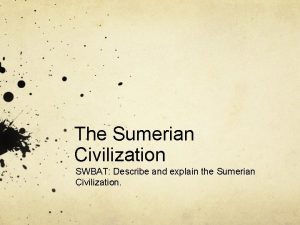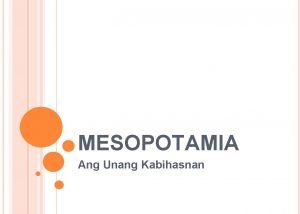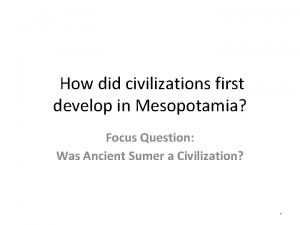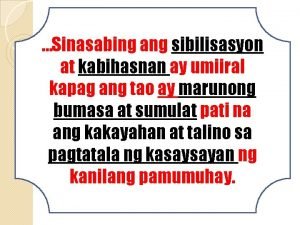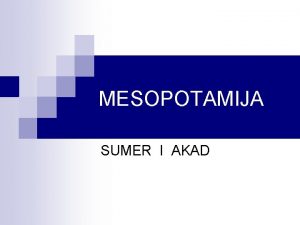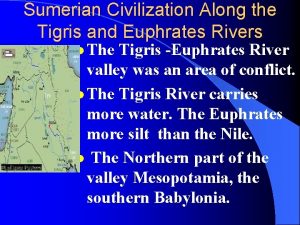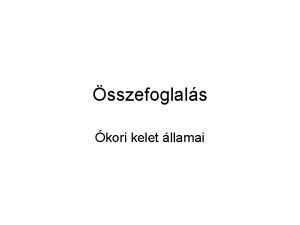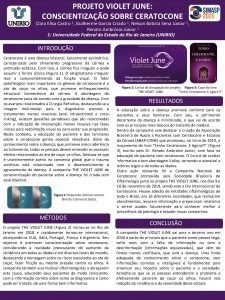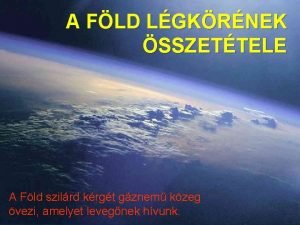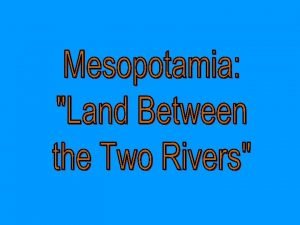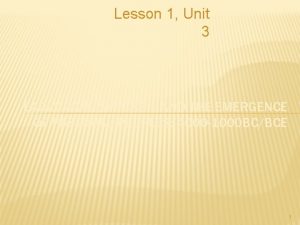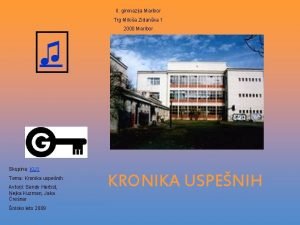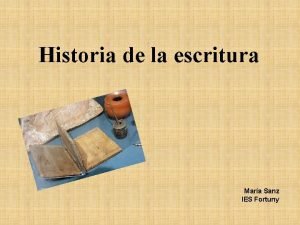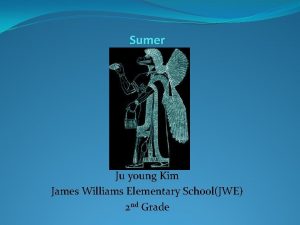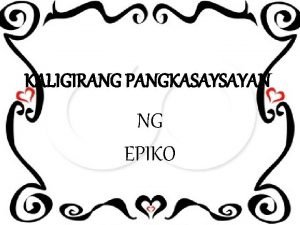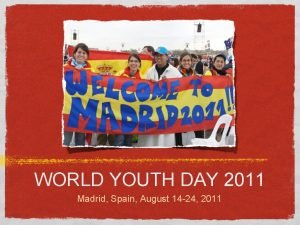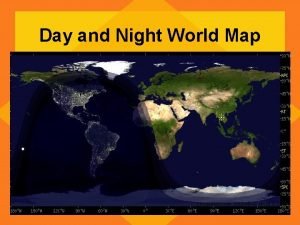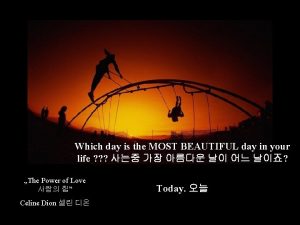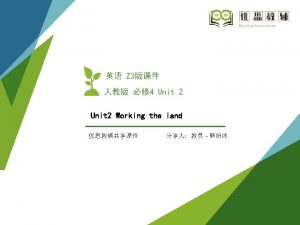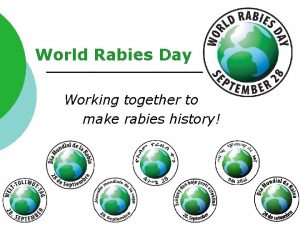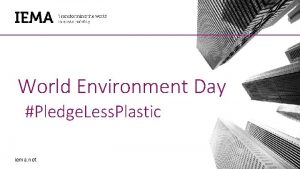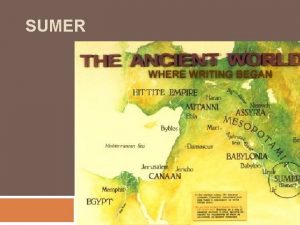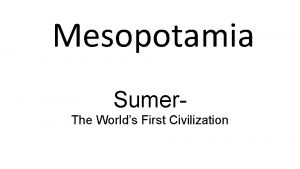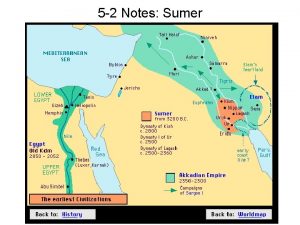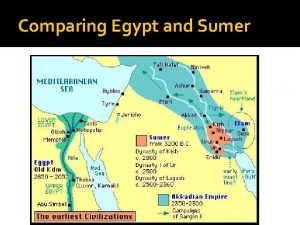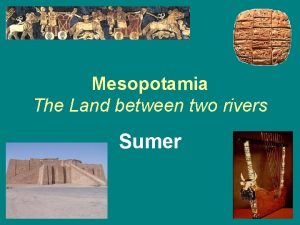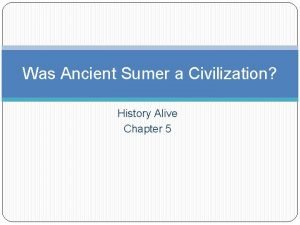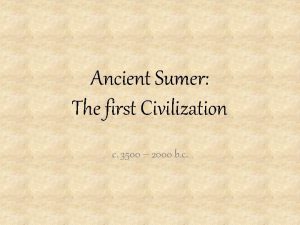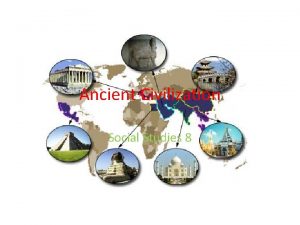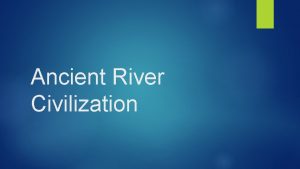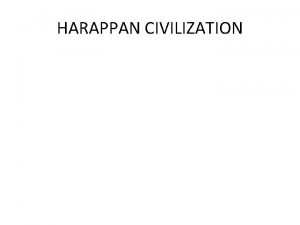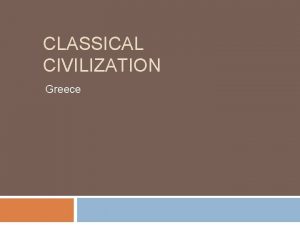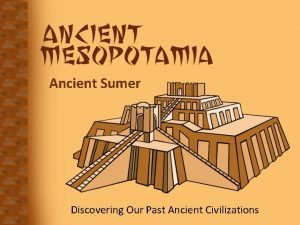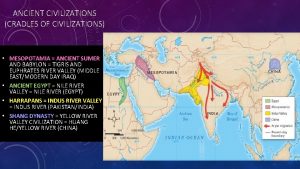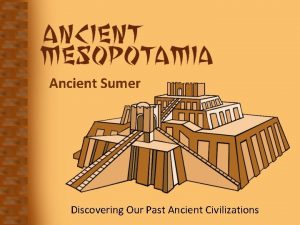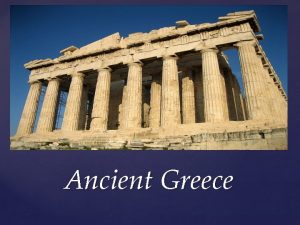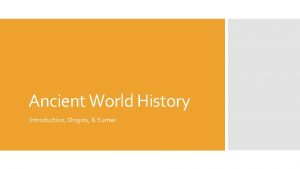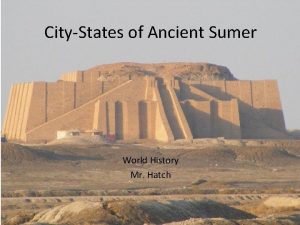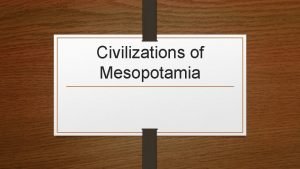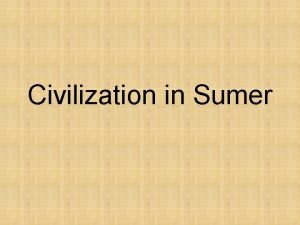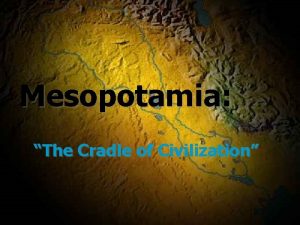Ancient World Was Ancient Sumer a Civilization Day

























































- Slides: 57

Ancient World Was Ancient Sumer a Civilization? Day 1

Preview • Scientists sometimes describe a society or group of humans as “highly civilized. ” What do you think this means? • Complete the spokes of the diagram on your handout with words that describe characteristics of a society that is highly civilized. For each spoke, draw and label a simple example of that description using a simple illustration.

Objectives • Students will – identify characteristics of civilization. – analyze artifacts from ancient Sumer and explain how they are examples of the various characteristics of civilization. – identify which Sumerian achievements most affect modern life – identify modern-day artifacts that are examples of characteristics of civilization.

Introduction Sumer was a region located on the southern Mesopotamian plains. It was settled around 3500 B. C. E. by Mesopotamians who were later known as Sumerians. Sumer extended over 10, 000 square miles—an area about the size of the state of Maryland—and consisted of various powerful city-states, such as Lagash, Ur, and Uruk. Mammoth Bone Hut

Introduction The Sumerian environment had a number of disadvantages—hot summers, a lack of rainfall, and rivers that flooded unpredictably. Historians believe the Sumerians’ struggles with this harsh environment inspired some of their greatest achievements. Many inventions, such as writing, the plow, and the sailboat, were adapted by other civilizations, and some are still in use today. For these reasons, some historians refer to Sumer as the “cradle of civilization. ”

Introduction • Let’s read 5. 1, the introduction, together. – When did archeologists begin finding artifacts in the region of Mesopotamia?

Introduction – Sketch in the current countries that comprise the “Fertile Crescent. ” – In what country can Mesopotamia be found today?

Introduction – What one artifact helped us to learn a great deal about Sumer? – Can you describe this artifact?

Characteristics of Civilizations • Read section 5. 2. • As you read, take notes over the seven characteristics of civilization.

Characteristics of Civilizations • A stable food supply – so that people have the food they need to survive • A social structure – with different social levels and jobs • A system of government – so that life in the society is orderly • A religious system -which involves a set of beliefs and forms of worship • A highly developed culture – that includes arts such as painting, architecture, music, and literature • Advances in technology • A highly developed written language

Textbook Reading • Read the remainder of chapter 5, taking notes as you read. • Afterwards, you will complete an activity using your information. • Timer

Skill Builder Activity • Get into pairs. • Posted around the room are placards of Sumerian achievements with a corresponding textual explanation. You will analyze each achievement to determine which characteristic of civilization it represents. • For each circle on your diagram, make a simple drawing of each artifact you analyzed that you think is an example of that characteristic of civilization and write a sentence: (name of artifact) relates to this characteristic of civilization because… • Remember: Most placards must be placed under more than one characteristic.

Skill Builder Activity • You will become an expert on the last placard you are at when time runs out and will present that placard to the rest of the class. • Timer • PARTNER A: You will now present the placard you are currently working on to the rest of the class. Make sure to explain why you placed it in the category you did.

Human Spectrum • PARTNER B: Gently remove the placard you are currently standing by and create a human spectrum at the front of the class, from “greatly influences today’s society” at one end to “doesn’t influence today’s society” at the other end. • Be prepared to defend your placement on the spectrum to the teacher and classmates. • Students may challenge your choice and you will need to defend your choice or move to a different area on the spectrum if you agree with the challenge. • Return your placard to it’s former location (please be careful with the placards!)

Process • Draw or find pictures of modern items that are examples of each characteristic of civilization and, as you place them on your spoke diagram, write a justification for the placement.

Activity Notes Review

5. 3 Notes: Stable Food Supply • The clay tablet relates to this characteristic of civilization because it tells that the Sumerians raised barley. • The stone seal showing plowing relates to this characteristic of civilization because it shows Sumerians preparing fields.

Water and Irrigation

Water and Irrigation • Why did civilizations often develop in river valleys? • Why did Sumerians develop irrigation, while Jericho and Çatal Höyük did not? • Why might Sumerians believe the gods caused their floods?

Domestication of Animals

Domestication of Animals • What were the two main purposes of domesticating animals? • What role did animals play in religion? How do you think this role developed?

5. 4 Notes: Social Structure • The statue of a chariot relates to this characteristic of civilization because it shows a military class. • The gold cup relates to this characteristic of civilization because it indicates a craftsperson and an upper class. • The clay seal of the king appointing a governor relates to this characteristic of civilization because it shows a government class. • The lyre relates to this characteristic of civilization because it indicates a craftsperson and an upper class that is entertained by music. • The clay tablet relates to this characteristic of civilization because it indicates a class of scribes and workers.

5. 5 Notes: Government • The clay tablet relates to this characteristic of civilization because it shows that government officials distributed grain. • The copper statue of a chariot relates to this characteristic of civilization because it shows that was an army. • The clay seal relates to this characteristic of civilization because it indicates there were governors and a king. • The statue of a king carrying a basket relates to this characteristic of civilization because it illustrates there was a king. • The lyre relates to this characteristic of civilization because it indicates there was a queen.

Security

Security • What was the role of the king? • What was the role of the army? • Why might the various city-states have attacked each other so frequently? • What positive interactions might there have been between the city-states?

5. 6 Notes: Religion • The statue of a king carrying a basket relates to this characteristic of civilization because it indicates that one of the king’s duties was to build temples. • The stone seal relates to this characteristic of civilization because it shows two gods. • The statue of a married couple relates t this characteristic of civilization because it was found in a shrine and might have been a gift to the gods.

Religion

Religion • Why might the temple be located in the center of the city? • What role did the temple play in Sumerian life? • Why do you think religion was such an important part of Sumerian life?

5. 7 Notes: The Arts • The statue of a married couple relates to this characteristic of a civilization because it shows there were sculptures. • The lyre relates to this characteristic of civilization because it shows Sumerians had music. • The statue of a king carrying a basket relates to this characteristic of a civilization because it shows they had metalworkers and architects for the temples. • The gold cup relates to this characteristic of a civilization because it shows there were skilled metalworkers.

5. 8 Notes: Technology • The copper statue of a chariot relates to this characteristic of a civilization because it shows the Sumerians had developed the wheel.

5. 9 Notes: Writing • The clay tablet, clay seal, stone seal, and statue of a king carrying a basket all relate to this characteristic of a civilization because they all have writing on them.

Invention and Creativity

Invention and Creativity • What allowed the Sumerians free time in which to develop innovations? • What were some of the main inventions of the Sumerians and why were each invented/what was their purpose? • Describe how and why cuneiform changed over time. • How was writing used in Sumer?

Lesson Development

IPG’s • The IPG’s are available on our Social Studies Department website. I also save a copy to my hard drive so that I’ll have it available. • The model lesson falls under the first unit of study titled, “Prehistory. ”

Notice the TEKS are already listed for you!

TEKS • History – The student understands traditional historical points of reference in world history. • 1. B—identify changes that resulted from important turning points in world history such as the development of farming – The student understands how the present relates to the past. • 2. A—identify elements in a contemporary situation that parallel a historical situation • • Geography – The Student understands the impact of geographic factors on major historic events • 12. A—locate places and regions of historical significance such as the Indus, Nile, Tigris and Euphrates, and Yellow (Huang He) river valleys and describe their physical and human characteristics

TEKS • Economics – The student understands the impact of the Neolithic agricultural revolution on humanity and the development of the first civilizations. • 13. A—identify important changes in human life caused by the Neolithic agricultural revolution • 13. B— explain economic, social, and geographic factors that led to the development of the first civilizations

TEKS • Science, technology, and society – The student understands how major scientific and mathematical discoveries and technological innovations have affected societies throughout history. • 23. A—give examples of major mathematical and scientific discoveries and technological innovations that occurred at different periods in history and describe the changes produced by these discoveries and innovations • Social Studies Skills – 25—The student applies criticalthinking skills to organize and use information acquired from a variety of sources including electronic technology. – 26—The student communicates in written, oral, and visual forms. – 27—The student uses problemsolving and decision-making skills, working independently and with others, in a variety of settings.

• Plan your lessons using a consistent model. I used the 5 E model for this lesson. • I’ve included a handout explaining each stage.

5 E Model of Instruction • • • Engage Explore Explain Elaborate Evaluate Formative Assessment should be the focus at these two stages






• Does anyone use any other common planning templates?

Notes • Ask questions that probe students prior knowledge about the characteristics of civilization. Back to Lesson

Notes • In the mid-1800 s. • For ELL, emphasize the vocabulary terms that students might struggle with in the reading. You might use any of several pre-reading vocabulary strategies available. Back to Lesson

Notes • You can have a student come up to the overhead map and point to the area. Back to Lesson

Notes • Standard of Ur was a Sumerian artifact with illustrations showing different aspects of Sumerian life. One side was called war and the other side peace. Back to Lesson

Notes • Different note sheets for grade level vs. pre-ap. Back to Lesson

Notes • Timers: Grade level around 15 minutes, pre-AP around 10 minutes. Add minutes if a majority of students are not finished. A few may need to finish at home. Encourage students to work together, not jigsaw it! • Optional: Have students work with a partner, taking turns being the Back to reader/writer, especially in Lesson inclusion classes with SPED or ELL.

Notes • Formative Assessment: As students complete this activity, the teacher should circulate around the room asking questions to check for understanding, encouraging students to elaborate in their responses. Start with simplier, lowerlevel questions (What is it? What characteristic does it fit in? ) and progress to more advanced levels (Why did you place it where you did? Could it go anywhere else? Why or why not? ) • Remember to provide adequate wait Back to time, especially for ELL. Lesson • Correct any misconceptions.

Notes • History Alive strategies, such as the Human Spectrum, can be adapted for almost any activity. • Check your Blah book for more ideas. Back to Lesson

Notes • This process will need to be completed for homework for most students. • Provide magazines or allow computer access, if desired. Back to Lesson

Notes • The actual notes for the activity are mainly for grade level students and are suggested responses. Most answers should have come out during the debrief of the activity. • The video clips and questions are for all students. The questions provide a way to formatively assess Back to students’ understanding before Lesson they work on the final assessment. • Clarify, as needed.
 Was ancient sumer a civilization chapter 5
Was ancient sumer a civilization chapter 5 Day 1 day 2 day 3 day 4
Day 1 day 2 day 3 day 4 Ancient sumer
Ancient sumer Day 1 day 2 day 817
Day 1 day 2 day 817 Aztec intellectual
Aztec intellectual Ancient egypt civilization geography
Ancient egypt civilization geography 4 river valley civilizations
4 river valley civilizations Ancient egypt civilization
Ancient egypt civilization Ancient civilization agriculture
Ancient civilization agriculture What are characteristics of civilization
What are characteristics of civilization Sumerian geography
Sumerian geography Sumer gulong
Sumer gulong Sumer geography
Sumer geography Sumer geography
Sumer geography Akadians long ago
Akadians long ago Sumer and akkad
Sumer and akkad Sibilisasyon sumer
Sibilisasyon sumer Sumer i akad
Sumer i akad Sümer yöneticilerine verilen isim
Sümer yöneticilerine verilen isim Sumerian civilization river
Sumerian civilization river Arhaikus
Arhaikus Violet sumer
Violet sumer Sumer főisten a levegő ura
Sumer főisten a levegő ura Sumer's most famous works of art
Sumer's most famous works of art Unit 3 lesson 1 sumer and mesopotamia
Unit 3 lesson 1 sumer and mesopotamia Iztok fošnarič
Iztok fošnarič Dibujos mesopotamicos
Dibujos mesopotamicos James williams elementary
James williams elementary Anong salitang griyego nagmula ang simposyum
Anong salitang griyego nagmula ang simposyum William beanes elementary school
William beanes elementary school Ocean the part day after day
Ocean the part day after day Day to day maintenance
Day to day maintenance As your room gets messier day by day, entropy is
As your room gets messier day by day, entropy is Tomorrow i don't know
Tomorrow i don't know Romeo and juliet timeline answer key
Romeo and juliet timeline answer key Growing day by day
Growing day by day Observation of seed germination day by day
Observation of seed germination day by day Germination conclusion
Germination conclusion Geotropism
Geotropism I live for jesus day after day
I live for jesus day after day One day in heaven
One day in heaven Day one day one noodle ss2
Day one day one noodle ss2 Dayone dayone noodles ss2
Dayone dayone noodles ss2 Ancient means of communication pictures
Ancient means of communication pictures Ancient india vs ancient china
Ancient india vs ancient china Wyd 2011 madrid
Wyd 2011 madrid World ict day
World ict day Day and night world map
Day and night world map World literature quiz 22
World literature quiz 22 World environment health day
World environment health day The most beautiful day in the world
The most beautiful day in the world Notice on world environment day
Notice on world environment day World rabies day logo
World rabies day logo World kidney day 2011
World kidney day 2011 Notice writing on environment day
Notice writing on environment day Free book day
Free book day Trees poem
Trees poem What is world earth day
What is world earth day
